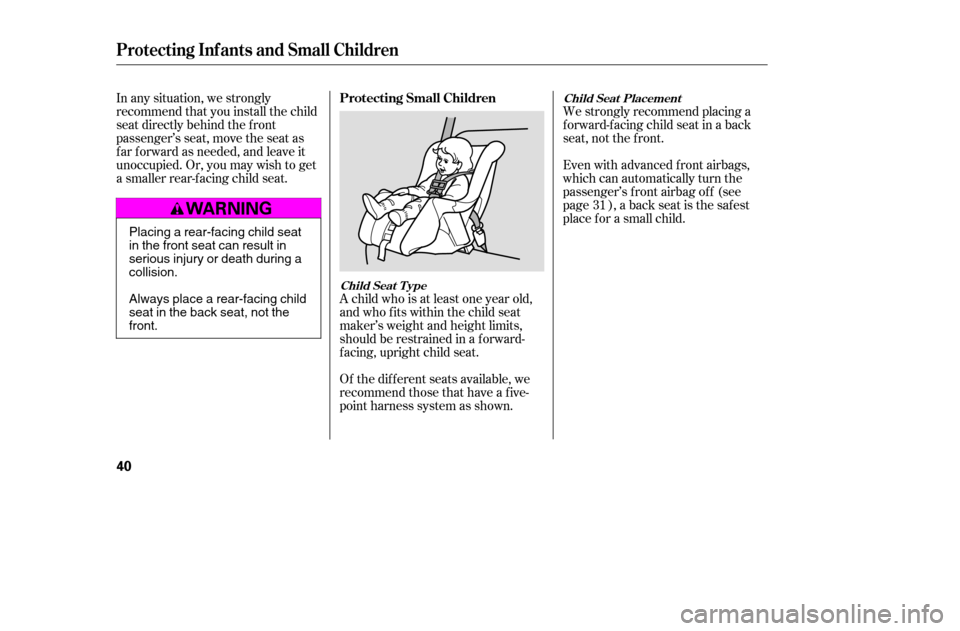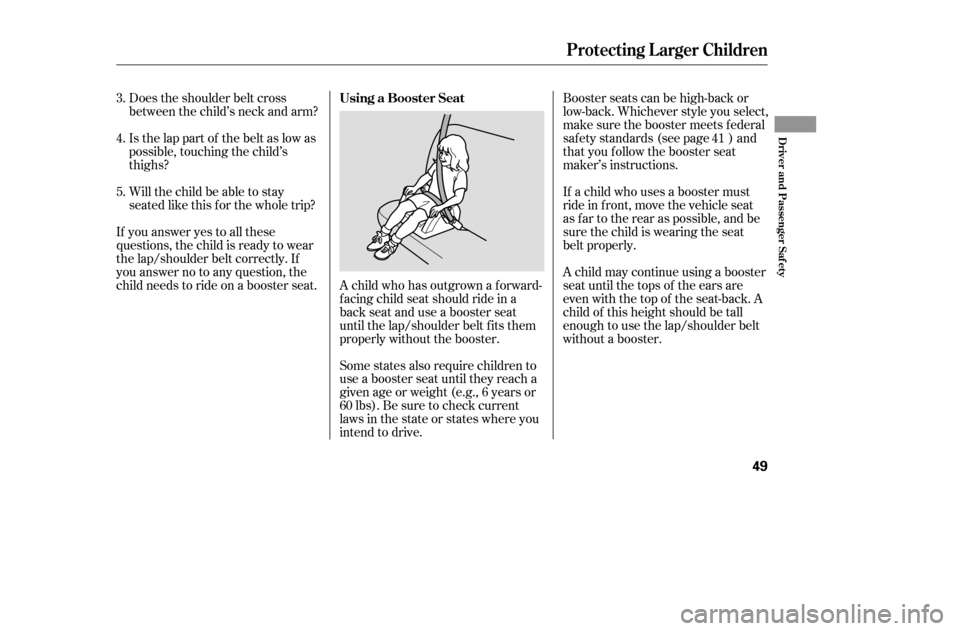Page 12 of 289

If the seat belt touches or crosses
your neck, or if it crosses your arm
instead of your shoulder, you need to
adjust the seat belt anchor height.
Insert the latch plate into the buckle,
then tug on the belt to make sure the
belt is securely latched. Check that
the belt is not twisted, because a
twisted belt can cause serious
injuries in a crash.
This spreads the f orces of a crash
over the strongest bones in your
upper body.
Position the lap part of the belt as
low as possible across your hips,
then pull up on the shoulder part of
the belt so the lap part f its snugly.
This lets your strong pelvic bones
take the force of a crash and reduces
the chance of internal injuries.
If necessary, pull up on the belt again
to remove any slack, then check that
the belt rests across the center of
your chest and over your shoulder.
Protecting A dults and Teens
Fasten and Position the Seat
Belts
5.
16
Improperly positioning the seat
belts can cause serious injury
or death in a crash.
Make sure all seat belts are
properly positioned beforedriving.
�����—�����—�����y�
�������������y���
�(�����������y�����
���y
Page 13 of 289

After all occupants have adjusted
their seats and put on seat belts, it is
very important that they continue to
sit upright, well back in their seats,
with their feet on the floor, until the
vehicle is parked and the engine is
of f .
Sitting improperly can increase the
chance of injury during a crash. For
example, if an occupant slouches,
lies down, turns sideways, sits
forward, leans forward or sideways,
or puts one or both f eet up, the
chance of injury during a crash is
greatly increased.
This could cause
very serious injuries in a crash.
See page f or additional
inf ormation about your seat belts
and how to take care of them.
If a seat belt doesn’t seem to work
properly, it may not protect the
occupant in a crash.
The front seats have adjustable seat
belt anchors. To adjust the height of
an anchor, press and hold the release
buttons and slide the anchor up or
down as needed (it has f our
positions). Using a seat
belt that is not working properly can
result in serious injury or death.
Have your dealer check the belt as
soon as possible.
20
CONT INUED
Maintain a Proper Sitting
Position
6.
Protecting A dults and Teens
Never place t he shoulder port ion of a
lap/shoulder belt under your arm orbehind your back.
No one should sit in a seat wit h aninoperat ive seat belt .
Driver and Passenger Saf ety
17
RELEASE
BUTTONS
�����—�����—�����y�
�������������y���
�(�����������y���������y
Page 35 of 289

CONT INUED
An inf ant must be properly
restrained in a rear-f acing, reclining
child seat until the child reaches the
seat maker’s weight or height limit
for the seat and the child is at least
one year old.
Only a rear-f acing child seat provides
proper support f or a baby’s head,
neck, and back.Two types of seats may be used: a
seat designed exclusively f or inf ants,
or a convertible seat used in the rear-
f acing, reclining mode.
If placed
f acing f orward, an inf ant could be
very seriously injured during a
f rontal collision. A rear-f acing child seat can be placed
in any seating position in the back
seat, but not in the f ront.
If the passenger’s f ront airbag
inflates, it can hit the back of the
child seat with enough f orce to kill or
seriously injure an inf ant.
When properly installed, a rear-
f acing child seat may prevent the
driver or a f ront passenger f rom
moving the seat as far back as
recommended, or f rom locking the
seat-back in the desired position.
Or, it can interf ere with proper
operation of the passenger’s
advanced front airbag system.
Protecting Inf ants and Small Children
Protecting Inf ants
Child Seat T ype Child Seat Placement
Do not put a rear-f acing child seat in a f orward-f acing position. Never put a
rear-f acing child seat in t he f ront seat .
Driver and Passenger Saf ety
39
�����—�����—�����y�
�������������y���
�(�����������y���������y
Page 36 of 289

A child who is at least one year old,
and who fits within the child seat
maker’s weight and height limits,
should be restrained in a f orward-
f acing, upright child seat.
Of the different seats available, we
recommend those that have a f ive-
point harness system as shown.We strongly recommend placing a
forward-facing child seat in a back
seat, not the f ront.
In any situation, we strongly
recommend that you install the child
seat directly behind the f ront
f ar f orward as needed, and leave it
unoccupied. Or, you may wish to get
a smaller rear-f acing child seat.
Even with advanced front airbags,
which can automatically turn the
passenger’s front airbag off (see
page ), a back seat is the saf est
place f or a small child.31
Protecting Inf ants and Small Children
Protecting Small Children
Child Seat T ype Child Seat Placement
40
Placing a rear-facing child seat
in the front seat can result in
serious injury or death during acollision.
Always place a rear-facing child
seat in the back seat, not thefront.
�����—�����—�����y�
�������������y���
�(�����������y���������y
passenger’s seat, move the seat as
Page 44 of 289

To determine if a lap/shoulder belt
properly f its a child, have the child
put on the seat belt, then ask
yourself :
When a child reaches the
recommended weight or height limit
for a forward-facing child seat, the
child should sit in a back seat on a
booster seat and wear a lap/shoulder
belt.
Does the child sit all the way back
against the seat?
Do the child’s knees bend
comf ortably over the edge of the
seat?
The f ollowing pages give
instructions on how to check proper
seat belt f it, what kind of booster
seat to use if one is needed, and
important precautions f or a child
who must sit in f ront.
1. 2.
Checking Seat Belt Fit
Protecting L arger Children
48
Allowing a child age 12 or under
to sit in front can result in injury
or death if the passenger’s front
airbag inflates.
If a larger child must ride in front,
move the vehicle seat as far
back as possible, use a booster
seat if needed, have the child
sit up properly and wear the
seat belt properly.
�����—�����—�����y�
�������������y���
�(�����������y�������
�y
Page 45 of 289

Does the shoulder belt cross
between the child’s neck and arm?
Is the lap part of the belt as low as
possible, touching the child’s
thighs?
Will the child be able to stay
seated like this f or the whole trip?
If you answer yes to all these
questions, the child is ready to wear
the lap/shoulder belt correctly. If
you answer no to any question, the
child needs to ride on a booster seat. A child who has outgrown a f orward- f acing child seat should ride in a
back seat and use a booster seat
until the lap/shoulder belt f its them
properly without the booster.
Some states also require children to
use a booster seat until they reach a
given age or weight (e.g., 6 years or
60 lbs). Be sure to check current
laws in the state or states where you
intend to drive.Booster seats can be high-back or
low-back. Whichever style you select,
make sure the booster meets f ederal
saf ety standards (see page ) and
that you f ollow the booster seat
maker’s instructions.
If a child who uses a booster must
ride in f ront, move the vehicle seat
as far to the rear as possible, and be
sure the child is wearing the seat
belt properly.
A child may continue using a booster
seat until the tops of the ears are
even with the top of the seat-back. A
child of this height should be tall
enough to use the lap/shoulder belt
without a booster.
4. 5.
3.
41
Protecting L arger Children
Using a Booster Seat
Driver and Passenger Saf ety
49
�����—�����—�����y�
������
������y���
�(�����������y���������y
Page 83 of 289

�µ
Raises or lowers the
seat.
Adjusts the seat-back
angle f orward or
backward.
Moves the f ront of the
seat up or down and
the rear of the seat up
or down.
Moves the seat
f orward and backward.
The controls f or the adjustable
driver’s power seat are on the
outside edge of the seat bottom. You
can adjust the power seat with the
ignition switch in any position. Make
all seat adjustments bef ore you start
driving.
Moving the long horizontal switch
adjusts the seat bottom in several
directions. The seat bottom adjusts
in the direction you move the switch.
The short vertical switch adjusts the
seat back angle.
The passenger’s seat also has power
adjustable controls. The 4-cylinder EX model without
leather interior has a power height
adjustment f or the driver’s seat. All
other seat adjustments in this model
are manual.
The DX and LX models have manual
seat adjustments (see next page).
The f ront passenger’s seat in all
4-cylinder models, and the LX V-6
See pages f or important saf ety
inf ormation and warnings about how toproperly position seats and seat-backs.
On EX-V6 model
OnEX,EX-L,LX-V6andEX-V6models
13 14
Power Seat A djustment
Seats
88
�����—�����—�����y�
�������������y���
�(�����������y�������
�y
models adjust manually.
Page 85 of 289
See page f or important saf etyinf ormation and a warning about how to
properly position the head restraints.
On DX and LX models On EX model
15
Your vehicle is equipped with head
restraints in all seating positions to
help protect you and your
passengers f rom whiplash and other
injuries.
The height of your driver’s seat is
power adjustable. Pull up on the
switch to raise the seat. Push it down
to lower the seat.
Make all adjustments bef ore you
start driving.
The height of your driver’s seat is
adjustable. To raise the seat bottom,
repeatedly pull up the lever on the
outside of the seat cushion. To lower
the seat, push the lever down
repeatedly. Head Restraints
Driver’s Seat Manual Height
Adjustment Driver’s Seat Power Height
Adjustment
Seats
90
RELEASE BUTTON
�����—�����—�����y�
�������������y���
�(�����������y���������y